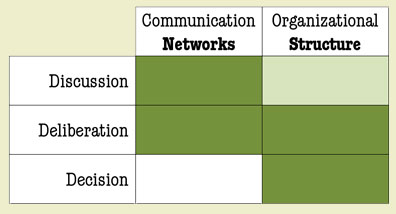I think this is something that I’ve always understood, but I know I will do well to better adopt and propagate this key concept. Organization structures and communication networks need to both be leveraged to their maximum potential in collective creativity and decision making.
The skilled leader will keep both the structures and the networks in harmonious tension. It is easy to err by failing on either side.
In my experience, we don’t need to do anything to create the communication networks; people talk. Our task is really to better acknowledge the networks and leverage them to their maximum potential; we can do more to enable the networks. Managers err when we build a culture that causes the networks to go underground, failing to acknowledge and encourage open communication. The extremes, with awful consequences, are those that attempt to forbid or punish open communication.
The opposite error is to fail to acknowledge the organization structure for decision making. We commonly forget that an open communication network does not negate what Catmull calls a “decision-making hierarchy.” Short circuiting, or even the perception of short circuiting, an organization structure generally results in chaos that includes poor decision making, bruised relationships, and damaged communication networks.
For a while now, we have adopted a vernacular for three stages of decision making:
- discussion,
- deliberation, and
- decision.
I think it is helpful to think of these ideas in a simple matrix: 
Collective creativity and sound decision making generally is best served by open discussion that may or may not involve the organizational structure. This is the early stage in the process characterized by brainstorming, floating of ideas, and what I often call swirl.
Deliberation ought to involve the networks and must consider the structure. This is the stage when operable plans come together. Productive deliberation should reflect the work of networks, and consider the structure in such a way that it results in a proposal that is actionable by the structure.
Decision, then, should be well informed by the networks via the previous stages, but entrusted to the organizational structure. The best decisions will include a feedback loop that demonstrates the value of the networks, especially when there is respectful disagreement.
If only it were this simple. Models like these are easily thrown by distrust and insecurity. Those in the communication networks may not be able to trust the organizational structure, even when open communication is enabled and thoroughly considered. Those in decision-making hierarchies may be so insecure that open communication is threatening, discouraged or disregarded. Then there are the added complications that might include legal constraints, confidentiality issues, and the various competing goals and perspectives of all involved. Nevertheless, sometimes a simple model like this helps, even in such complexities.
.
3 comments:
I'd want to know swirl would happen in a place where someone wouldn't say they're bored with it. That all ideas could come onto the table without judgment - for sifting by the group.
Good observation. It seems to me that some part of the challenge is finding the "right table." There are all sorts of situations where every idea simply can't be placed on every table. I like the word "sifting." I know I've blown it from time to time by not skillfully sifting at the right time, place or level. If folk are "bored" in the process, they may be at the wrong table, or the idea may be on the wrong table.
Great reflections on an important topic, Dan. The matrix is helpful, yet organizational or network decision making does not always flow along such linear lines. It seems the larger the bureaucracy, the more complicated the decision making processes. And the more dysfunctional the organization is, the more polemic the conversation becomes--a few examples come to mind. Thanks for sharing and I'll pass your thoughts on to other members of our team.
Post a Comment